The best thing one can do when it’s raining is to let it rain. ∼ Henry Wadsworth Longfellow
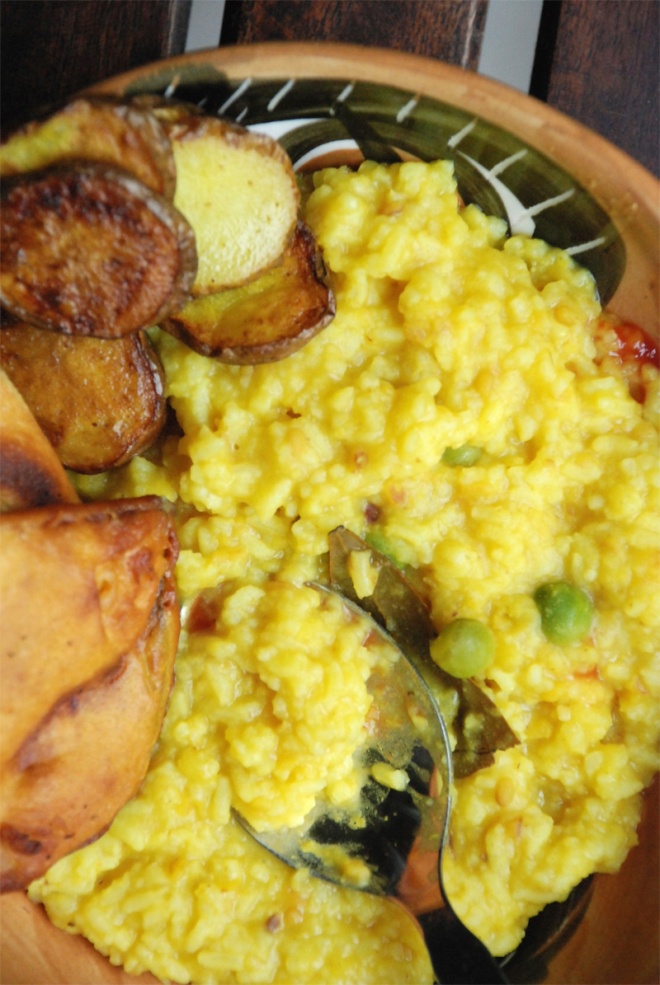
And of course cook something appropriate for the rains… Khichuri?
Khichuri or Khichdi (a dish made up of rice and lentils) as it’s known in many parts of India can be conjured up as a delicacy unlike in many parts of India where it is a basic meal served during ailment and sickness. For Bengalis, Khichuri is synonymous to writing love letters – it requires more punch and accompaniments than other meals. Also, the ambiance required to serve Khichuri is also the same – romantic thunderstorm and dark rolling clouds out bursting into torrential rains and the Bengali soul craves for Khichuri. In Bengal, Khichuri has attained a celebrity status, a cult-companion in a romantic rainy day. We have managed to make Khichuri a celebrity food by turning it into a delicacy, a gourmet food and a must-have dish on a romantic rainy day! And don’t forget to scroll till the end of the post to congratulate Khichuri as it emerges as a harbinger of hope.
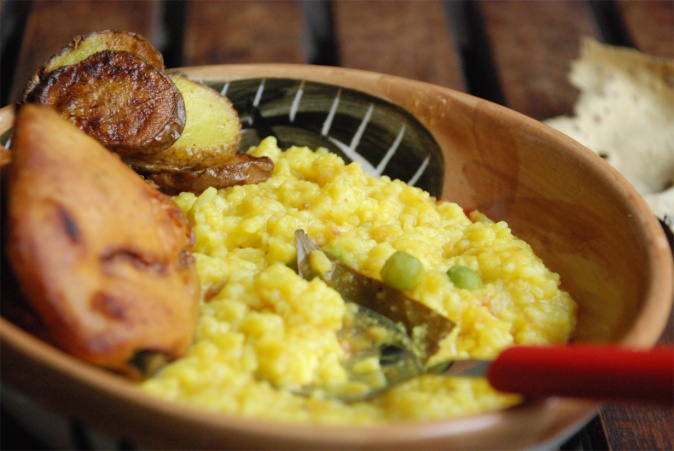
The Bengali Khichuri – a celebrity in it’s own right with star entourage!
Unfortunately, only Khichuri doesn’t suffice. It has to be accompanied by a whole lot of fried and frittered vegetables lovingly called Beguni/batter-fried Eggplant, Kumri/batter-fried Pumpkin, Aloor Fuluri/batter-fried Potatoes, Papad bhaja/Pappadam, Chutney and many more. And to top it all and making this simple Khichuri a gourmet variety is to serve Ilishmaach bhaja/fried Hilsa. Hilsa, being the quintessential Bengali fish, elevating the Bengali’s love for fish into a notoriously snooty level. The Bengali Khichuri also crowns the Bhog/offering to the deities during any religious worship. Bhog-er Khichuri has a different and an unique taste as compared to the Khichuris made at home. Probably it has got to do with the spiritual and religious devotion with which the former is cooked and the abundant Ghee/Clarified butter poured in it as compared to the Khichuri that is cooked traditionally at homes where the home-makers are conscious about cholesterol and saturated fats! Vegetables such as cauliflower, potato, and green peas are commonly added into the Khichuri. In a sense, Khichuri can be treated as a complete meal by itself but Bengalis believe in a bit of opulence, at-least where food is concerned. The luxurious accompaniments as seen in the following pictures…
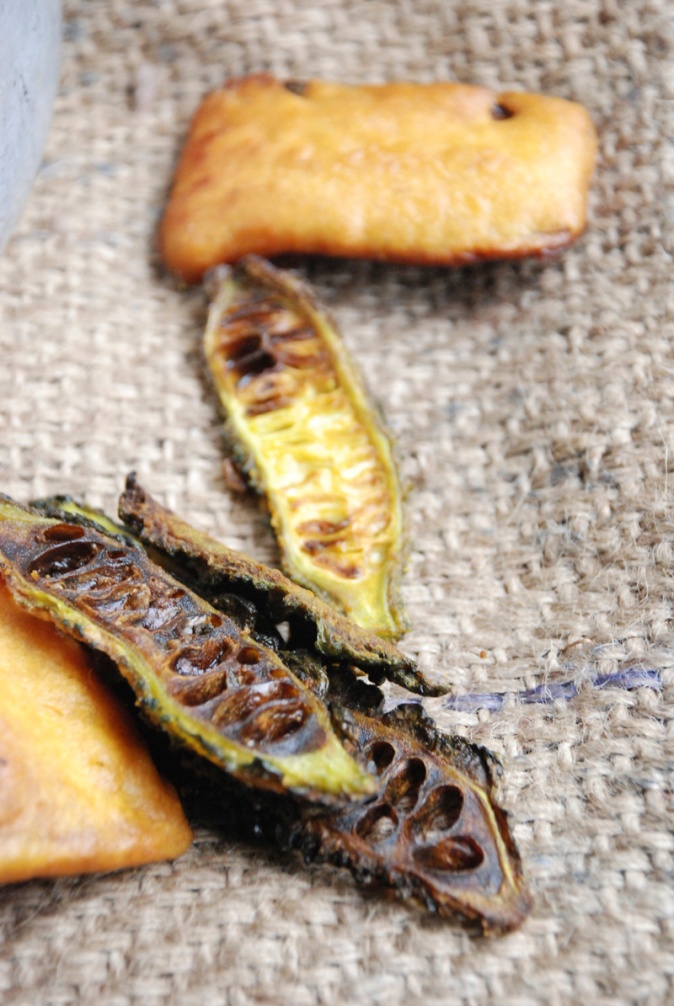

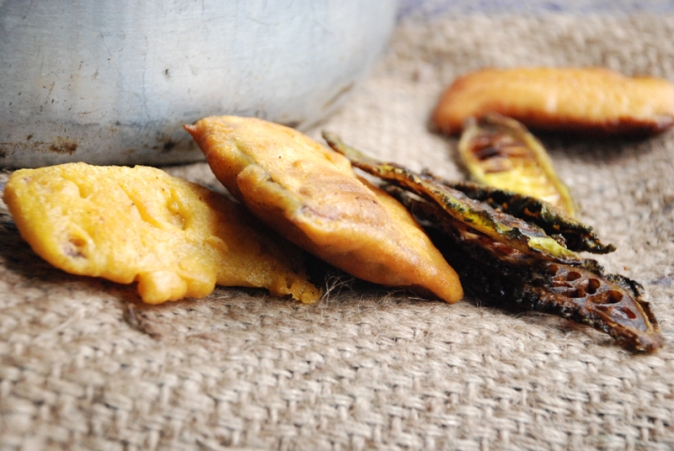
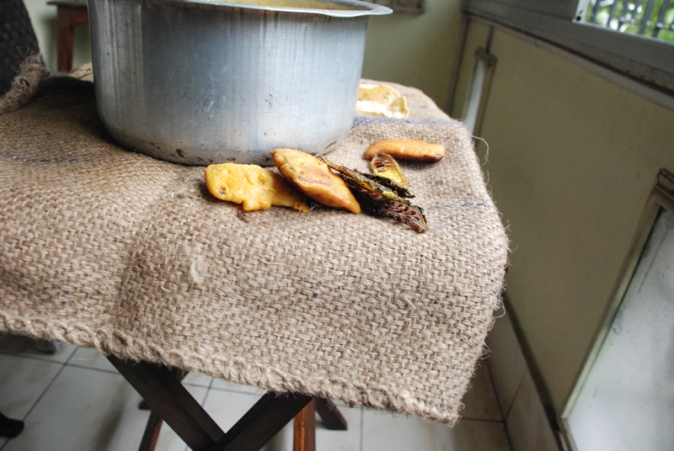
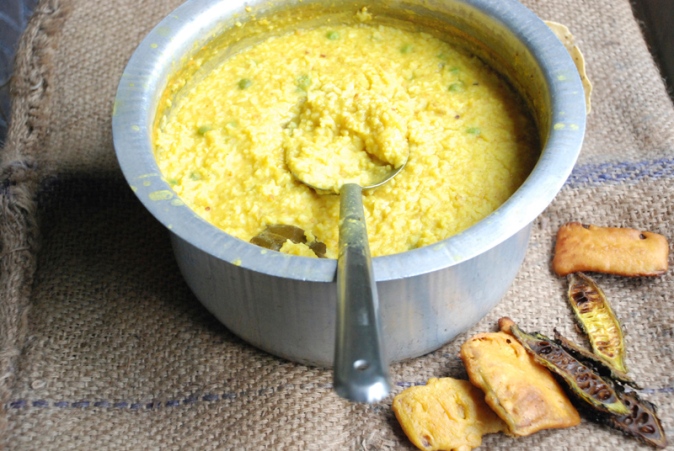
A bowl of Khichuri with all the accompaniments (Beguni/Eggplant batter-fried, Aloo bhaja/Potato fried and Papad shown here)…

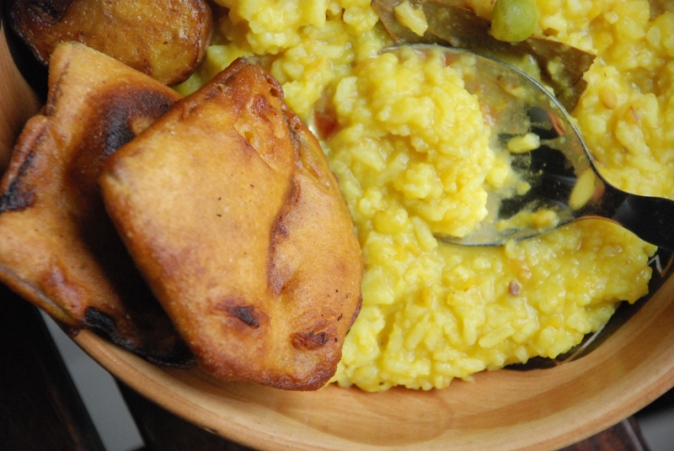

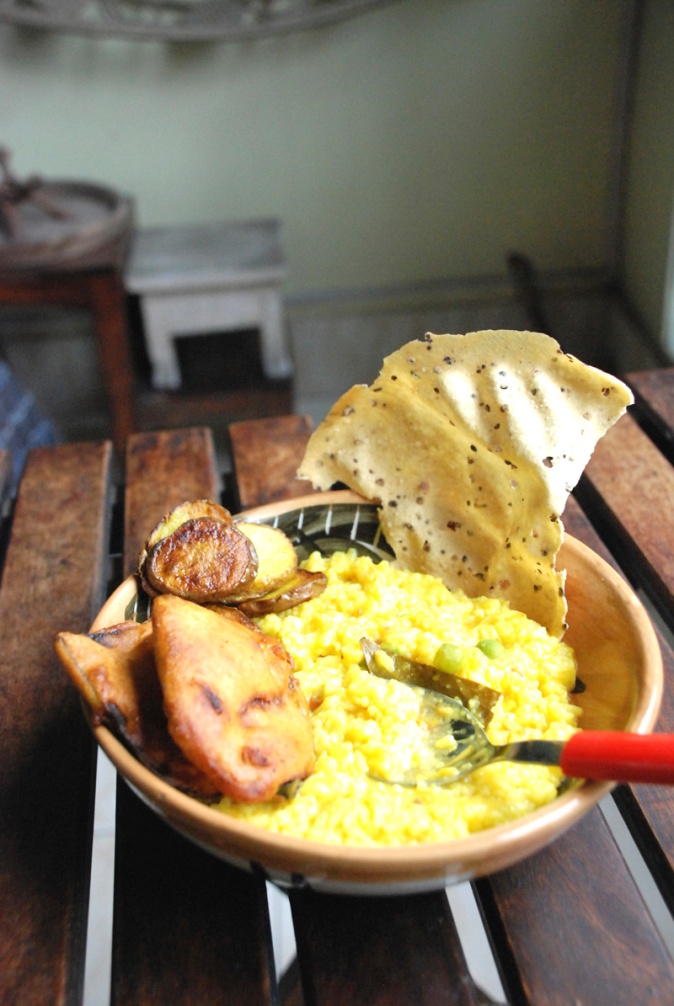
Khichuri or Rice Lentil Dish
The preparation of Khichuri varies from one household to another. The spices differ. The consistency differs. The vegetables that are put into the mixed pot differs as well. It all depends upon personal preferences. Children can easily help in making the dish (my two little sous-chéfs are aged 8 and 3 11 and 6 years!). And lastly, guaranteed to be tasty!(Preparation of the Khichuri – 45-50 minutes; Chopping the accompanying Vegetables for making the Fritters – 10 minutes; Frying the Vegetable Fritters – 30 minutes)
Ingredients
1-1/2 Cup Raw Basmati Rice (or preferably GobindoBhog Rice*)
1-1/2 Cup Moong Dal/ Yellow Lentils
1 tsp Cumin Powder
1/2 tsp Red Chilli Powder
1/2 tsp Turmeric Powder
1/2 tsp Sugar
Whole Ginger – 1 inch in size, grated
Potatoes – 4 pieces, cut into half
Onions – 2 big pieces, cut into quarters
Green Peas – 1 cup
White Oil – 2 tbsp
Water – 7 cups (the quantity will vary depending upon how soupy one prefers it)
The Seasoning/Tempering
2 tbsp Ghee
2 Bay Leaves
1 Red Chilli Whole
4 Green Cardamoms
6 Cloves
2 Cinnamon Sticks, 1 inch in size
Method
Wash the rich thoroughly & drain the water. – Roast the Moong Dal – Heat the White Oil in a Dekchi**. Gently fry the Potatoes and keep them seperately – Add the Onions, grated Ginger, Turmeric, Cumin Powder, Chilli Powder, Salt, Rice and the roasted Moong Dal – Add the Water and cover the Dekchi with a lid let it simmer till the Rice and Dal is half done – Add the Potatoes and Green Peas and let it simmer again till the vegetables (like Cauliflower florets, Tomatoes etc) are cooked – Add the Sugar – You may have to add some more water if you prefer your Khichuri to be more soupy. While the vegetables shouldn’t be over cooked, the Rice and Dal should be cooked to the level where they can be described as ‘mashy’! – Slit the Green Chillies and add just for the flavour
For the Tempering – Heat the Ghee in a small wok – Stir in the Red Chillies, Bay Leaves, Whole Garam Masala – Cloves, Cinnamon and Cardamom Sticks, without burning them! – Pour into the cooked Khichuri
*The fragrant Rice that is traditionally used in making Bengali Payesh/Bengali Rice Pudding is a special type of Rice called Gobindobhog. Wikipedia defines it as ‘Gobindobhog is a rice referenced in ancient Indian literature. It was used as an offering to the gods because it was known to be, “The rice preferred by the gods”. It is a short grain, white, aromatic, sticky rice. It is grown traditionally in West Bengal, India. It has many traditional Bengali recipes intended for it specifically. It has a sweet buttery flavor and a potent aroma.’
Availability of Gobindobhog outside India: Our stint in Colombo, Frankfurt and Dubai suggests that if these are available outside India, they can only be found in Bangladeshi shops and Asian supermarkets selling Bangladeshi products. There is a type of rice which comes from Bangladesh – the Chinigura Rice (similar to Basmati and Jasmine rice but with very tiny, short grains, resembling sushi rice). The latter, though less fragrant than Gobindobhog Rice is easily available in Bangladeshi shops in the Sharjah Backet. You may use a fragrant Basmati rice as well… As I must have mentioned in my earlier posts, after all it’s the journey with all it’s imperfections that will stay in the memory, not the perfect tit-bits!
In what will you make the Khichuri? ** I prefer to cook my Khichuri and everything related to Rice – Plain Rice, Pulao, Payesh/Bengali Rice Pudding, Biriyani etc, in the quintessential Dekchi. I may be a Microwave Mummy and the greatest fan of Pressure Cookers and Non-stick pans but this is the only time when I am all for the old traditional Dekchi! But what is a Dekchi? Sutapa, the grand-dame of Bengali food blogging (14 years into food blogging!), in her beautiful post – ‘Introduction to Bengali Cooking‘ describes it as ‘the handle-less modification of the sauce pan – the rimmed, deep, flat-bottomed Dekchi which is a hallmark of the Bengali kitchen!
A glimpse of the Dekchi full of hot Khichuri below… 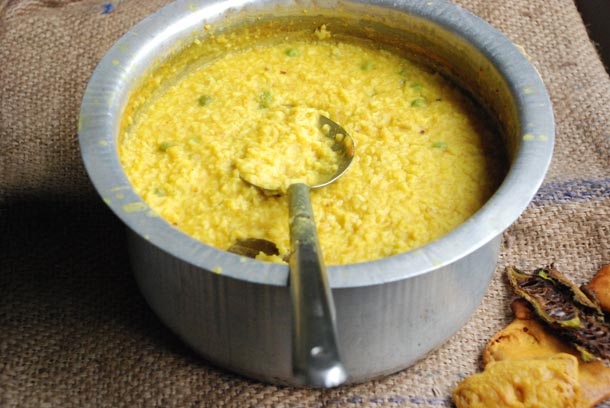
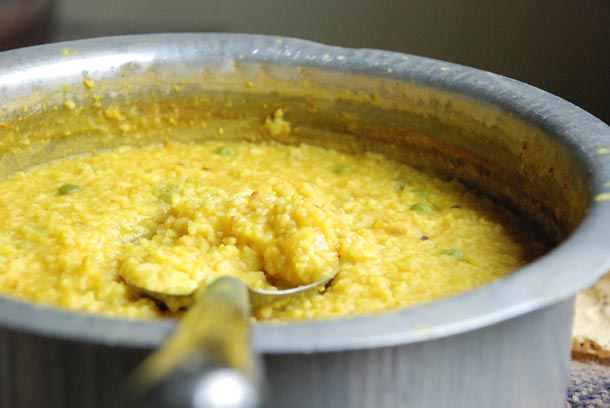
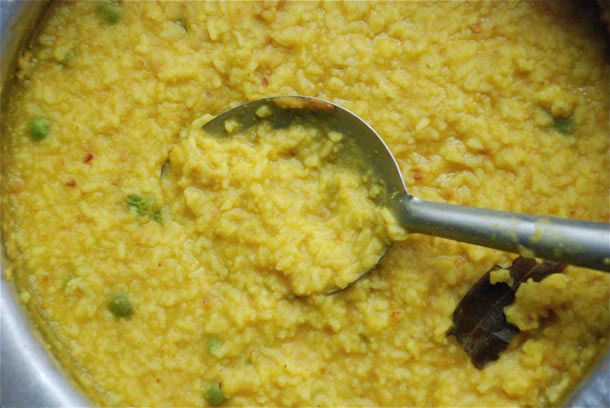

Beguni or Aubergine Fritters
Beguni is the humble accompaniment of Khichuri. Bengali Khichuri is seldom had alone. Beguni-s or Eggplant or Aubergine or Brinjal slices deep fried in a batter. They can be had as a stand-alone tea-time snack as well and goes very well with Muri/Puffed Rice. It is a very popular street snack as well. The similar European version is known as Aubergine Fritters
Ingredients
4 medium sized Eggplants, sliced longitudinally
2 cups Besan/Chickpea Flour/Bengal Gram Flour
1-1/2 cup Water (the Batter should be thick)
1/2 tsp Turmeric Powder
1/2 tsp Salt
1/2 tsp Kalo Jeera Seeds/Nigella/Kalonji/Black Cumin Seeds
1 cup White Oil, for deep frying
Method
Wash the Eggplants and cut them into into thin slices – Mix the Turmeric Powder, Salt, Kalo Jeera Seeds into the Besan along with some water to form a batter and whisk it well till the paste is thick and smooth without any lumps – Heat the Oil in a Deep frying pan or Wok (if the Oil is not sufficiently heated the Fritters would be fried soggily) – Dip the Eggplant slices into the Batter generously and fry in the hot oil till they are golden brown and crispy – Serve them hot as a stand-alone snack or with it’s celebrated counterpart – the Bengali Khichuri! Adding a small amount of baking powder to the Batter makes the Fritters more crunchy. Many prefer to add a small amount of Posto/Poppy seeds. Note: In a similar manner one could make Kumri/Pumpkin Fritters, Aloori/ Potato Fritters and anything that you can think of!
A glimpse of notoriously crunchy Beguni below…
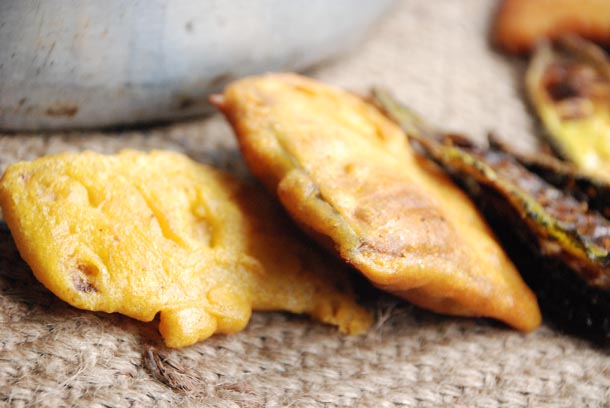
Khichuri is not a common dish by any means… Khichṛī or khichdi, khichri, khichdee, khichadi, khichuri, khichari, kitcheree, kitchree are various names by which Khichuri is called in various regions of India. Though the method of preparation vary considerably amongst the various regions. The word originates from the Sanskrit word Khicca, meaning a dish based on rice and pulses. It is possibly an inspiration for the Anglo-Indian dish of Kedgeree. During the British colonial rule (1858— 1947), the khichdi recipe was modified to suit the Anglo Indian palate, by adding fish and eggs to the ingredients. Kedgeree became popular during the British era as a staple breakfast food. It soon spread outside India to the UK during the reign of Queen Victoria. French traveler, Jean-Baptiste Tavernier, who came to India six times during 1640–1685, mentions that Khichdi prepared with green lentils, rice and butter, was a typical peasant evening meal. Even before that, Seleucus Nicator, a Greek ambassador (ca. 358 BC–281 BC), records the popularity of this rice and pulses meal in South Asia. Khichuri is described in the writings of Afanasiy Nikitin, a Russian adventurer who travelled to the South Asia in the 15th century. Khichuri was very popular with the Mughals, especially Jahangir. Ain-i-Akbari, a 16th century document, written by Mughal Emperor, Akbar’s vizier, Abu’l-Fazl ibn Mubarak, mentions the recipe for khichdi, which gives seven variations! Infact, during the Mughal dynasty (1400—1700s), the traditional khichdi went through various adaptations. They made it rich by adding strong spices, dry fruits and nuts. Mughal Emperor Jahangir popularized this dish and it is believed that Emperor Aurangzeb was particularly fond of khichdi! Khichuri travels borders, boundaries and breaks all barriers… and becomes Khichdi!
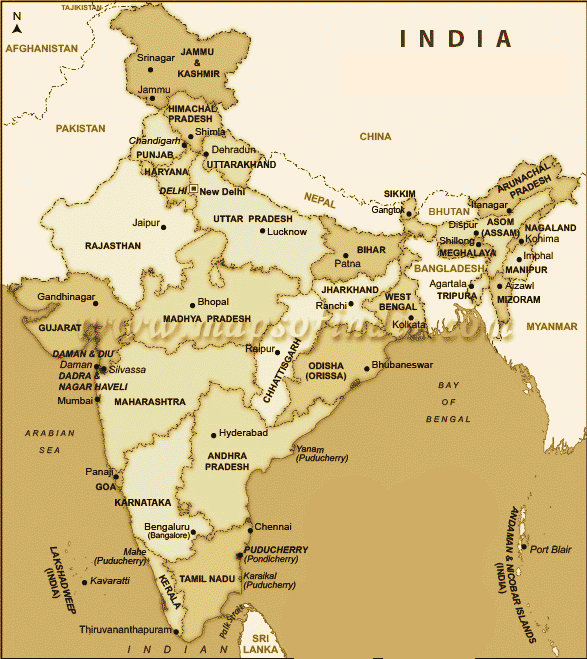
Khichdi is a very popular dish across Pakistan, Northern India, Eastern India and Bangladesh. The dish is widely prepared in many Indian states like Bihar, Jharkhand, Uttar Pradesh, Orissa, Gujarat, Maharashtra, and Bengal (you may see the above map of India for reference. Map Courtesy: here) Khitchuri is traditional diet and daily meal of people of the Kutch region in Gujarat, India. It is also a very popular dish of Suratis in southern Gujarat. While Khichuri is an elaborate meal in Bengal, it is cooked very differently in northern and western India, where it is considered a very plain and bland dish served as comfort-food during ailment. Khichdi is also the first solid that babies are introduced to. Rice and lentils are simmered till mushy, seasoned with turmeric and salt, and fed to infants to introduce them to solid food. Khichri is also popular in Pakistan where it is especially cooked for children and people with stomach problems as it is easily digestible compared to other Pakistani dishes which usually have meat and are also spicy. Not to be confused with Khichra (with an ‘A’ in the end) is actually a variation of Halim or Haleem, a special Ramadan dish made of wheat, barley, meat (usually beef or mutton, but sometimes chicken or minced meat), lentils and spices. In Bangladesh, Khichuri is a popular dish had during Ramadan. Khichdi, when well cooked with a little oil, is considered a light and nutritious dish – a Satwik dish, and is especially popular amongst many who follow an Ayurvedic diet or nature cure. Khechidi as is known in Orissa has many varieties. Adahengu Khechidi (ginger-asafoetida khichdi), Moong Dal Khichdi/Yellow Lentil Khichdi. Adahengu Khechidi is a popular dish in the famous Jagannath Temple in Puri as well. At home, moong dal Khechidi and other Khechidis are served with Pampad, pickle, curd, Aaloo Bharta/Mashed Potato, or Baigan Bharta/Mashed Eggplant, Raita/Yoghurt Dip and chutney. Khichri is also very popular in Bihar. It is made with rice, dal, and Garam Masala, cooked into a semi-paste like consistency and eaten with lots of Ghee, Baigan ka bharta/Mashed Potato, Aaloo ka bharta (mashed potato with onions, green chilli, salt and mustard oil), tomato chutney (blanched tomato, onion, green chilli, grated ginger and mustard oil), Pāpaṛ/Pappadam, tilori (a fried snack), and mango pickle. It is customary to eat Khichdi every Saturday in Bihar, and also at dinner during Makar Sankranti, an auspicious day of the Harvest festival for the Hindus. Bisi Bele Bath or Hot Lentil Rice is famous variant of Kichdi from Karnataka, in Southern India. Pongal, a similar dish is popular in Southern India, primarily in Tamilnadu. It is primarily made of rice and lentils, and seasoned with black pepper, cumin, and cashews. Disclaimer: Info Courtesy on Khichuri – Wikipedia, Indian Currents

 Life through Grilled Windows and Balconies and Hoping beyond… Why did this post on Khichuri originate in the first case? Shira, a very close blogger friend of mine has tagged me along in a HOPE RELAY. This ‘relay’ asks bloggers to touch on the topic of hope. Her blog In Persuit of More sums up ‘Hope’ in more than one way. ‘The blog about living with (just a little) less. By going without, we can gain – by giving to those who have less… Imagine how you can turn that into something positive for those who would otherwise go hungry. Go without so others don’t have to. That’s living with (just a little) less’! What better dish can there be than Khichuri to write a post on Hope? And which better city can there be than Kolkata from where I can write this post? Kolkata throbs in my heart, wherever I am and whichever city I have set my home in. Borrowing from my past articles to describe my feeling – Kolkata is my city, my home. It stirs up my emotions, it stirs up my soul. The city at dusk through the heavy dark thunder clouds, the incessant noise from the crowded streets, the familiar and the unfamiliar faces, the multiple options of local savouries, the hurtling riot of colours – these rejuvenate me. Born and brought up for the most part in Kolkata, my Bengali genes are to be blamed not only for my relentless creative pursuits but also my unsatiated taste-buds. Wherever I go or whichever city I have lived in and set up our homes later in my life, there has always been a reference to something or someplace or somebody or some incident in Kolkata. Not because I grew up here. But because of the city’s resilience, its spontaneity, it’s survival strategies. An over-populated urban hub situated in an equally over-populated country has it’s own nuisance value. A bit of rain leads to water-logging, a bit of sunshine dries up the road-side wells and cracks up the tars on the roads.
Life through Grilled Windows and Balconies and Hoping beyond… Why did this post on Khichuri originate in the first case? Shira, a very close blogger friend of mine has tagged me along in a HOPE RELAY. This ‘relay’ asks bloggers to touch on the topic of hope. Her blog In Persuit of More sums up ‘Hope’ in more than one way. ‘The blog about living with (just a little) less. By going without, we can gain – by giving to those who have less… Imagine how you can turn that into something positive for those who would otherwise go hungry. Go without so others don’t have to. That’s living with (just a little) less’! What better dish can there be than Khichuri to write a post on Hope? And which better city can there be than Kolkata from where I can write this post? Kolkata throbs in my heart, wherever I am and whichever city I have set my home in. Borrowing from my past articles to describe my feeling – Kolkata is my city, my home. It stirs up my emotions, it stirs up my soul. The city at dusk through the heavy dark thunder clouds, the incessant noise from the crowded streets, the familiar and the unfamiliar faces, the multiple options of local savouries, the hurtling riot of colours – these rejuvenate me. Born and brought up for the most part in Kolkata, my Bengali genes are to be blamed not only for my relentless creative pursuits but also my unsatiated taste-buds. Wherever I go or whichever city I have lived in and set up our homes later in my life, there has always been a reference to something or someplace or somebody or some incident in Kolkata. Not because I grew up here. But because of the city’s resilience, its spontaneity, it’s survival strategies. An over-populated urban hub situated in an equally over-populated country has it’s own nuisance value. A bit of rain leads to water-logging, a bit of sunshine dries up the road-side wells and cracks up the tars on the roads.
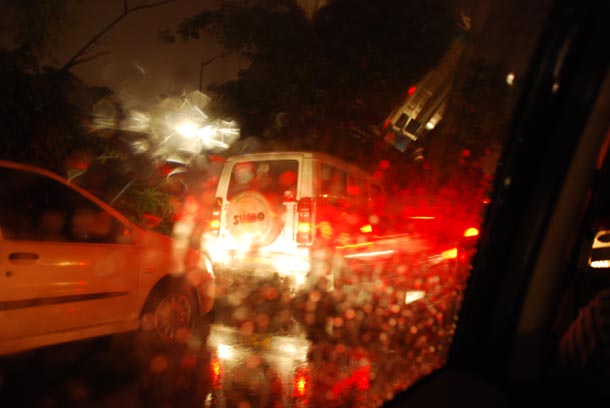
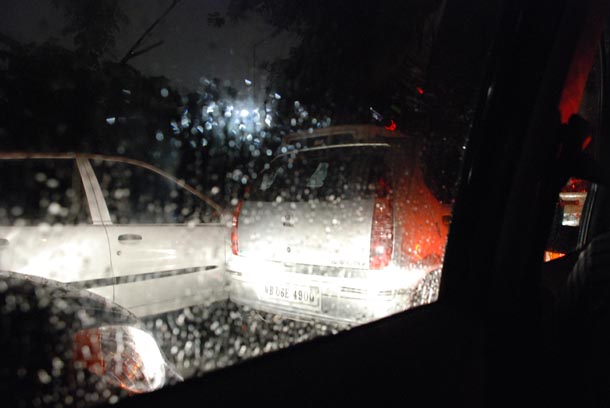
Stuck in the traffic in EM Bypass, inside an air-conditioned car while it rains torrentially outside and as I see the flurry of drenched people – men, women and children, scurrying to get into packed over-crowded buses, I do believe that there is HOPE. HOPE that the rains would eventually stop when the same bunch of fatigued people – the same people – men, women and children emerge out of the bus as they near their homes. HOPE that their fatigue would be gone when they are hugged by that one special person at home, waiting to open the door!
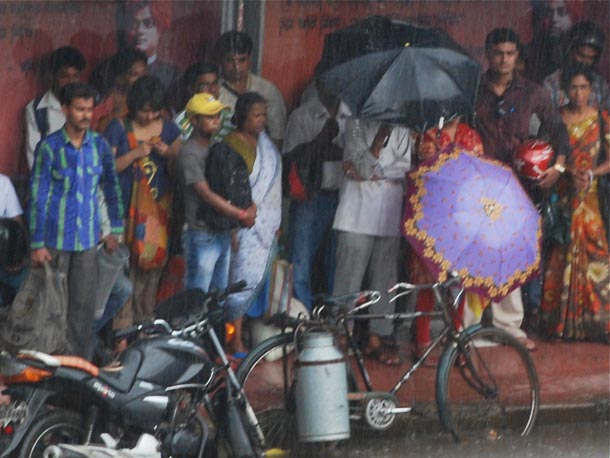
HOPE that even after it has rained the whole night when I wake up in the morning and look out through my grilled windows I can see the streaks of sunlight pouring in with the hope that the rains would stop and today would be the brightest day of all! HOPE that after the rains stop, I’ll be smiling happily as I see the rain-drenched greenest of green leaves – smelling fresh after the showers!
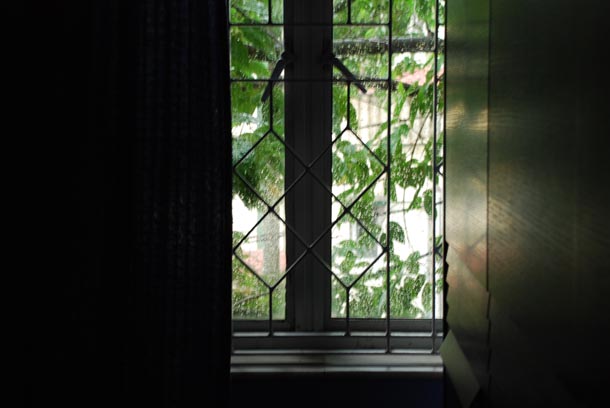
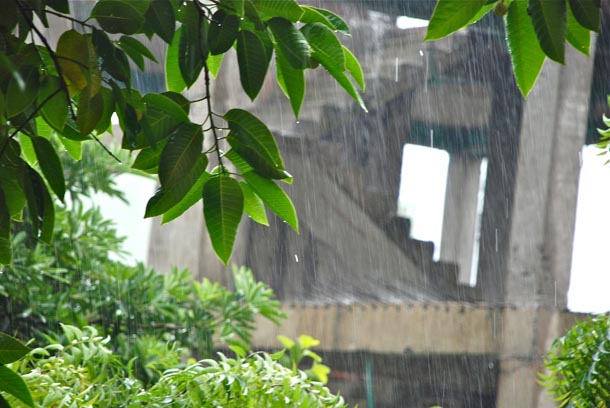
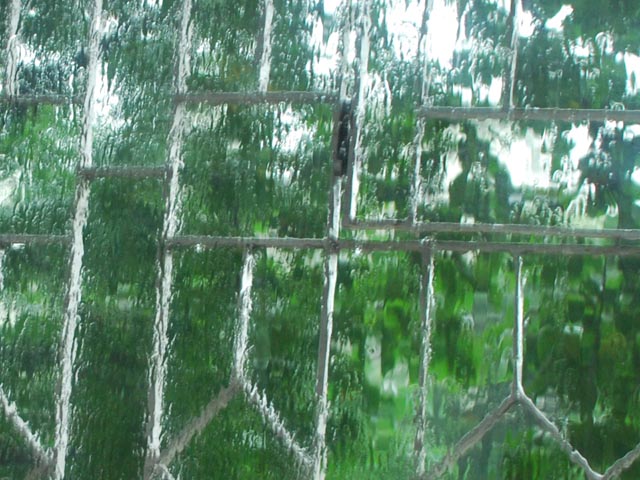
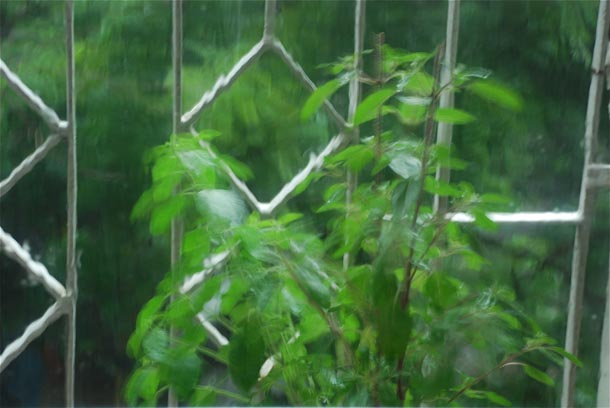
The freshly drenched leaves of the Kadam tree…
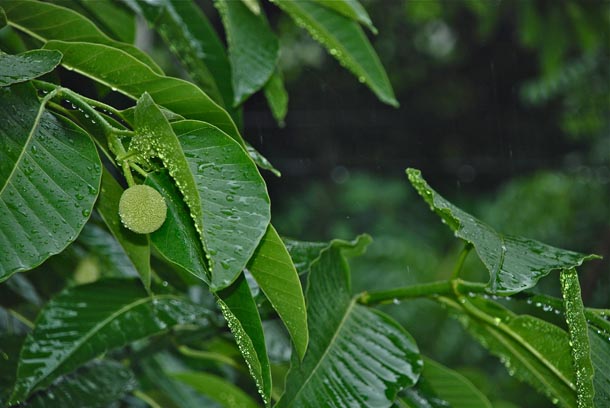
HOPE that the lives of everyone dwelling down below in the city is also oh-so-perfect and beautiful as it seems from the the 31st floor of the plush high-rise apartment of a dear friend of mine, as we laugh and have a good time with my old school friends! HOPE that everyone walking on the streets of the city has a home at least!
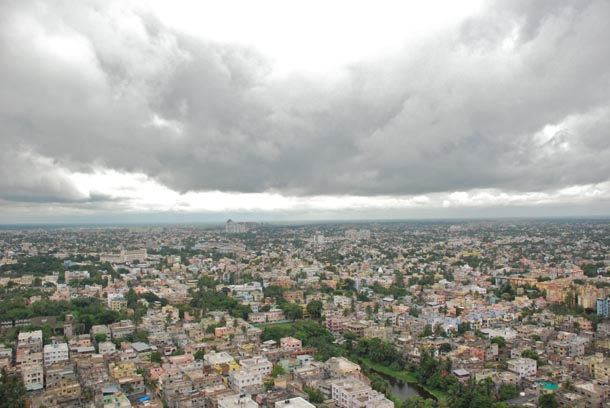

HOPE that the children of the hundreds of homeless who have created their rambling homes under the Gariahat Fly-over and yet manage to play a game of football with their naked feet and a shape-less football at the end of the day, will someday be playing in some proper park or will be able to have 4 walls and a proper ceiling defining their homes instead of the space under a Fly-over! HOPE that the child sleeping on the pavement today gets at-least a bed and a pillow to sleep on tomorrow!

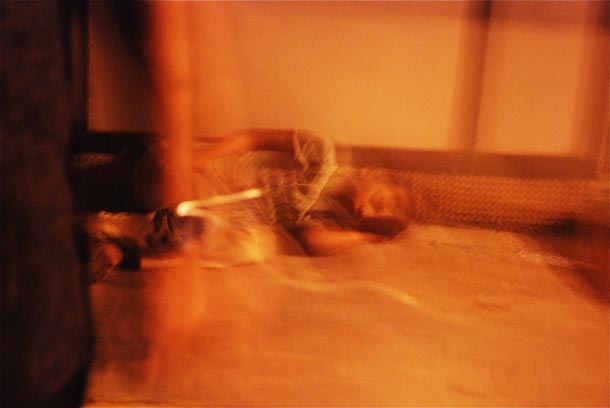

Khichuri as the harbinger of HOPE… When I ask the street urchin munching away some food bought from a street shack, shelling out a mighty 10 rupees earned by him (not derived from begging, as he pointed out to me) – ‘Ki khachish tui?/What are you eating?’… he answered ‘Khichuri-Beguni‘! Surprised that I had asked this very obvious question. True, Khichuri-Beguni are perhaps the only food that connects all of us – from the fortunate ones to the unfortunate ones in this ‘City of Joy’ as Dominique Lapierre has called Kolkata to be in his famous novel. Whether it’s the gourmet variety served in fine porcelain plates on a well laid out dining table or it is served in aluminium foil or plates made out of Shaal pata/Leaves from Shaal tree, it is Khichuri which transcends all social strata and curriculum and fills our tummy and hungry souls! As always, requesting you to enjoy the pictures without using them.
Unblogging it all… Ishita
Disclaimer: However, the subject, story, opinions and views stated here are my own and are independent. While you enjoy reading my posts with lot of visuals, please do not use any material from these posts. Do join me on my daily food and travel journey on Instagram, Facebook and Twitter.
——————————————————————————————————–
Here are the next few blogs tagged in this relay – they are not necessarily food bloggers but give me HOPE at various levels…
In Persuit of More – Shira talks about living with (just a little). She gives me the HOPE that the only thing that can take us through our life is positivity…
Walking on Sunshine – Sally, a food blogger otherwise (My Custard Pie) first started sharing her thoughts in this blog with a very fixed purpose in mind – training, fund-raising for and documenting a challenge for charity along part of the Lebanon Mountain Eco Trail. She gives me the HOPE that we can do much more than what we are doing…
In Bits N Pieces – Aveek who has gone through a lot of personal struggle still manages to be a creative soul finding inspiration everyday in the environment he lives in, enjoying his city, her streets, her people and their lifestyle. His blog is new but gives me the HOPE that he will find his solace through this blog…
Ginger And Scotch – Sandy tries to trace back her roots as she travels the world and writes a food blog in Dubai. She is also trying to give back to society by creating a Resource page with proceeds going to charity…
The Yellow Diaries – Lisa Ray is a film celebrity. I do not personally know her. But she gives me all the HOPE that everything can be fought against – even CANCER…
——————————————————————————————————–
Related articles
- Momos in Tiretti Bazar – The Last Chinese Remnants! (ishitaunblogged.com)
- Phuchkas in Vivekananda Park (ishitaunblogged.com)
- Firni or Ferni, Ramadan or Ramzan, Mallick Bazar or Karama? (ishitaunblogged.com)


Making Khichuri tomorrow…just to jog my memory along with my taste buds. Lovely article Ishita.
LikeLike
Fantastic! Only Khichuri or with all the Bengali ‘frittery’ paraphernalia?
LikeLike
I want the rains with some sizzling hot khichuri too!!! Yet another very beautifully expressed blog on one of the simplest of foods in the world! Thanks Ish pish for some great reading!
LikeLike
Kanaka, what can I say. Your comments and feedback always make my day. Am trying to pen down as I feel… let’s see where it takes me!
LikeLike
Really enjoyed the post and pics. We make our khichuri with the green lentils, but yours looks soooo much better. I too now long for some rain, but not easy to come by in Dubai:(
LikeLike
Yeah there’s no fixed rule… even within Bengali households the recipe differs. Was also wanting to point out the regional differences within Bengal – but thought that might be too heavy for some readers. Thank you for your lovely comment – wish could send you some rain. Right now sharing virtually:)
LikeLike
Thanks so much for the mention – really honoured. Hope is an under-rated virtue. The stuff of life.
LikeLike
So true Sally. Hope is an under-rated virtue. But definitely one of the most important ingredients. That realisation hits more strongly if you visited the city that I love so much – Kolkata. Everything is floating on hope:)
LikeLike
amazing as asual. love how you combine the nostalgia for cal and the food thoughts it evokes.
LikeLike
Thank you Satyen:) Please keep on leaving your comments… look forward to them.Also feedback from another passionate foodie helps.
LikeLike
So beautiful and detailed post about the humble khichdi ,great dear!! loved this Bengali version of khichdi ..will surely try this and yes all the clicks are so beautiful and specially loved the rain drenched kadam tree!!!
LikeLike
Thank you Anjana… actually miss the rains so very much here:)
LikeLike
Pingback: Mutton Kassa With Red Wine And Red Grapes «
Pingback: Crusted Paneer Potato with Kiwi Sauce «
Pingback: Authentic Bengali Cuisine… In ‘Slight’ Details «
Pingback: Rasgulla Macapuno On TV & Shubho Bijoya to all! «
Pingback: Living By The Water With Sunset As Prop – Kolkata & the Ganges «
Pingback: Semaiya Kheer/Vermicelli Pudding, Eid in Dubai… Eid Mubarak! «
Pingback: Gajorer Payesh/Carrot Pudding… Wishing Everyone A Happy Diwali! «
Pingback: Notun Gurer Payesh/Traditional Bengali Rice Pudding & My Dida «
Pingback: Shondesh/Sandesh Pudding… Guest Post For Sudeshna From Cook Like A Bong! «
Pingback: Giving Back! «
Pingback: Best of 2012 | Season’s Greetings and 3 Cookbooks Giveaway «
Pingback: Shorshe Bata Maach – Mustard Salmon In This Case | A Detour From Thailand To Wish Shubho Noboborsho! |
To add to the “harbinger of hope” theme …
I found this blog entry because I was looking for a recipe to attach to a story on school lunches in Bangladesh.
‘Instead of the micronutrient-fortified biscuits usually provided in school feeding programmes in Bangladesh, children in 63 schools will receive a freshly-prepared nutritious kichuri every day at lunch time. The meals are made from locally procured rice, pulses, nutrient-fortified oil and home-grown vegetables. The rice is fortified with six essential vitamins and minerals, helping ensure the children get all the nutrients they need to grow and learn well.’
That’s definitely HOPE!
Lee-Gwen
http://www.wfp.org/news/news-release/wfp-and-government-launch-cooked-school-meals-initiative-bangladesh?utm_source=newsletter&utm_medium=email&utm_campaign=enews-july2013-supporters-Global
LikeLike
Pingback: Kumro Bhaaté or Mashed Pumpkin Bengali Style And I Ask What The Heck Was Halloween? |
Pingback: Stories of Love, Nostalgia And Memories – The Ingredients To My Cooking |
Pingback: Opening Up My Bengali Kitchen For Dima Sharif | #RamadanSpecial2014 |
Pingback: Italian Cuisine World Summit 2014 | Learning To Cook Risotto The Italian Way | IshitaUnblogged
So nicely written
LikeLike
Pingback: Payesh or Rice Pudding For My Birthday | Power of Gratitude Messages | IshitaUnblogged
Pingback: Where Will You Eat Bengali Food In Kolkata? | From Traditional to Bohemian | IshitaUnblogged
Pingback: Press The Freaking Publish Button with This Freaking Fish Biryani! – IshitaUnblogged
Pingback: IshitaUnblogged - Dacres Lane | Introducing Kolkata street food in BBC Travel Show UK
Pingback: Shubho Bijoya to all | Immerse in the bond of food and love